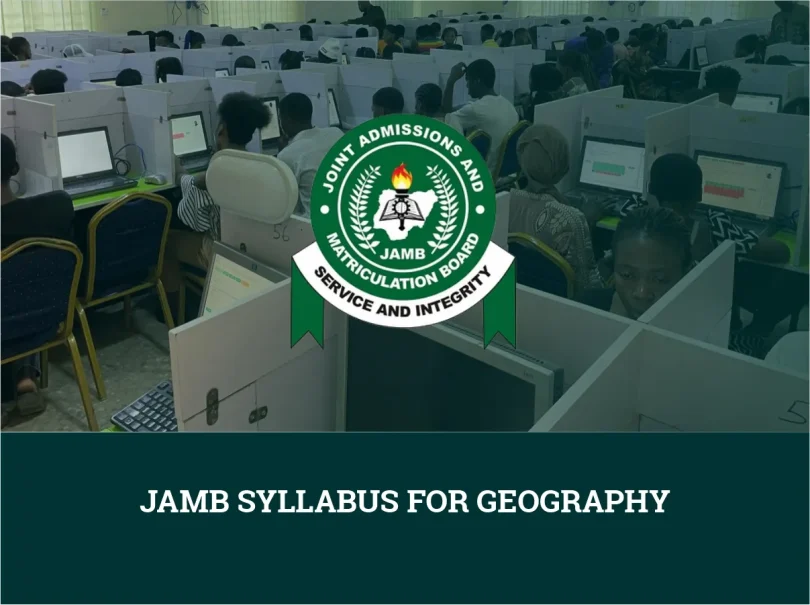Has JAMB released the JAMB Syllabus for Geography for the 2025 academic year? This is a frequently asked question every year for candidates who want to write the Unified Tertiary and Matriculation Examination. Yes, just as always, JAMB has released the syllabi for all subjects, including Geography, which is the subject of concentration on this page.
The JAMB syllabus for Geography 2025 is out, and candidates can confidently use the syllabus to study and prepare for the Geography examination.
Do you need guidance on how to get a copy of the JAMB Syllabus for Geography? Carefully follow the information on this page, as it is written to assist you in understanding the topics, objectives, and recommended materials necessary for the examination.
A Complete Outline of JAMB Syllabus for Geography 2025
Here is a comprehensive and structured outline of the JAMB Geography Syllabus for 2025/2026, organized into key sections with corresponding topics and objectives to guide your preparation:
Section A: Practical Geography
| Topic | Objectives |
|---|---|
| Map Reading and Interpretation | Understand map scales, measurement of distances, directions, bearings, and gradients. |
| Map Drawing | Develop skills in drawing sketch maps and cross profiles. |
| Interpretation of Statistical Data | Interpret data presented in various forms such as graphs, charts, and tables. |
| Fieldwork Techniques | Apply field observation methods and data collection techniques. |
Section B: Physical Geography
| Topic | Objectives |
|---|---|
| The Earth and the Solar System | Understand the structure of the Earth and its position in the solar system. |
| Weather and Climate | Analyze elements of weather and climate, and their effects on human activities. |
| Landforms | Identify and explain the formation of various landforms. |
| Rocks and Minerals | Classify rocks and minerals, and understand their economic importance. |
| Vegetation | Study types of vegetation and their distribution. |
| Soils | Understand soil formation, types, and their significance. |
| Oceans and Seas | Examine the characteristics and importance of oceans and seas. |
| Environmental Hazards | Identify natural hazards and their impact on the environment. |
Section C: Human Geography
| Topic | Objectives |
|---|---|
| Population | Analyze population distribution, density, and growth. |
| Settlement | Understand types of settlements and their patterns. |
| Transportation and Communication | Evaluate the development and significance of transportation and communication systems. |
| Economic Activities | Study various economic activities such as agriculture, mining, and manufacturing. |
| Trade and Commerce | Understand the principles of trade and commerce, and their impact on the economy. |
| Urbanization | Examine the process of urbanization and its effects. |
Section D: Regional Geography
| Topic | Objectives |
|---|---|
| Nigeria | Study the physical and human geography of Nigeria. |
| Africa | Understand the geographical features and human activities in Africa. |
| The World | Analyze global geographical patterns and issues |
Examination Structure
The JAMB Geography examination structure is designed to assess candidates’ understanding and application of geographical concepts, skills, and principles. The exam typically follows a multiple-choice format and is conducted via computer-based testing (CBT). Here’s a breakdown of its key features:
Mode of Examination: Computer-Based Test (CBT)
Number of Questions: The exam usually consists of 40 to 50 multiple-choice questions.
Duration: Candidates are given 1 hour to complete the Geography section.
Coverage: The questions span across four major areas:
- Practical Geography – including map reading, data interpretation, and basic surveying techniques.
- Physical Geography – covering topics like weather, climate, landforms, vegetation, and environmental hazards.
- Human Geography – involving population studies, settlements, and economic activities.
- Regional Geography – focusing on Nigeria, West Africa, and major world regions.
Scoring: Each question carries equal marks. There is no penalty for wrong answers, so students are encouraged to attempt all questions.
JAMB Recommended Textbooks for Geography
To effectively prepare for the JAMB Geography examination, consider studying the following recommended textbooks:
- Certificate Physical and Human Geography for Senior Secondary School by B.O. Adeleke, O. Areola, and G.C. Leong
- Contemporary World Regional Geography by M. Bradshaw et al.
- General Geography in Diagrams for West Africa by R.B. Bunet and P.O. Okunrotifa
- Collins New Secondary Atlas by Macmillan
- Introduction to Geography by D. Fellman et al.
- A New Geography of West Africa by N.P. Iloeje
- Map Reading of West Africa by D.A. Nimako
- A Regional Geography of Africa by P.O. Okunrotifa and S. Michael
- Geographical Regions of Nigeria by R.K. Udo
- Geography: An Integrated Approach by D. Waugh







Leave a Comment